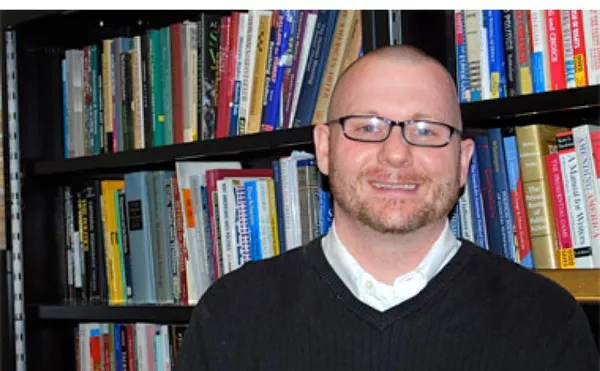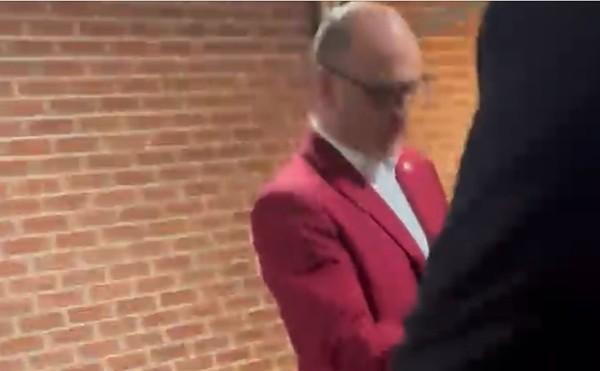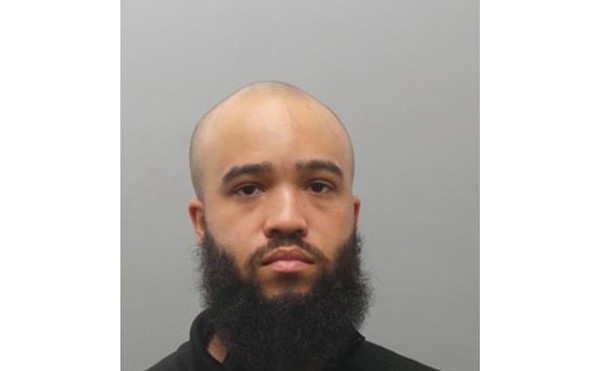The Bellefontaine Neighbors Police Department has spent the past three years refereeing a freakish feud between the neighbors at numbers four and five on Green Acres Road. The trouble began with a dispute over a driveway, then snowballed into a bizarre free-for-all involving everything from name-calling to stalking to cross-burning.
The fight continues. And it gets stranger by the day.
"They've been arrested, they've been fined, they've been talked to," sighs Mayor Marty Rudloff. "We've done everything we can within the legal realm of discipline. You do your best, but some problems just don't go away. It ends up that somebody moves, or files a lawsuit."
This week MacArthur Moten, a St. Louis attorney, will file a lawsuit in St. Louis County Circuit Court on behalf of Patricia McIntosh and her twelve-year-old daughter, Robyn. The suit charges the woman's next-door neighbors, Keith Dagenais and William Johnston, with assault and infliction of emotional distress. McIntosh is seeking $95,000 in damages.
The McIntoshes, who are black, claim that Dagenais and Johnston, both gay whites, erected and burned a six-foot-tall cross in their yard and hung a black doll with a noose around its neck in plain view of their home.
The 42-year-old McIntosh and her attorney suggest that the cross and doll were used to cast an evil spell on Robyn, traumatizing the girl and causing an astonishing array of medical problems.
The extraordinary lawsuit -- seemingly drafted with the help of Roget's Thesaurus -- goes so far as to state that Robyn's "muscles, bones, cartilage, ligaments, tendons, tissues, nerves, blood vessels, membranes and all the parts and structures thereof were seriously bruised, contused, lacerated, cut, torn, swollen, aggravated, ruptured, mashed, wrenched, narrowed, compressed, subluxed [sic], abraded, dislocated, strained, sprained and rendered stiff, sore and painful."
So does McIntosh think the neighbors were practicing voodoo on her daughter?
"I'm not going to dispute that," she replies.
McIntosh says Robyn began acting oddly about two years ago. "She was afraid to go outside and play like a normal kid. She didn't want to sleep alone in her room anymore," McIntosh recalls.
She declined to address what medical care Robyn received but says several sessions with a psychiatrist and a year of academic tutoring have helped her daughter. "She still asks permission to go outside, and she's very watchful," McIntosh notes.
Robyn's problems aside, McIntosh alleges in the suit that Dagenais and Johnston "engaged in an intentional illegal campaign of terror" against her between July 2000 and July 2004 by placing a threatening note on her car, hurling racial slurs and threatening her with bodily harm.
"I find the petition preposterous," fumes James Dailey Wahl, the St. Louis attorney who represents Dagenais and Johnston. "I think the allegations and conclusions contained therein have no basis in fact."
Dagenais did not return repeated phone calls, and Johnston slammed his door shut when asked to comment for this article.
The feud erupted in the spring of 2002, when Johnston and Dagenais hired surveyors to delineate the property line between the neighbors' driveways, which abut each other. McIntosh remembers Johnston and Dagenais asking if she'd seen a survey stick that was missing.
Dagenais and Johnston then painted a white line on the driveways to demarcate the properties, she says.
"It escalated from the stick to them putting outside these little spiritual objects with smoke coming out of them, and Keith would be walking up and down the driveway throwing water and saying all kinds of things," claims McIntosh. "Next thing you know, there were three sixes written all over their garage and a black doll hanging in their window with a noose around its neck. They were blocking the driveway to prevent me from getting in, and then they were harassing my kids."
The quarrelling neighbors complained to police for even the most mundane offenses: The water from her car-washing is flooding my basement! He has six "do not disturb" signs planted in his front lawn! And on and on it went.
Police finally filed charges of disturbing the peace against Dagenais and McIntosh in December 2002 and January 2003, respectively.
On the evening of February 9, 2003, Green Acres residents held a vigil outside Greater St. Mark's Family Church to pray for racial harmony in the community of 11,000.
The vigil lured KTVI-TV (Channel 2) reporter Andrew Baker and photographer Lynn Henzel to cover the conflict. Outside his home, Dagenais told the reporters he was not a racist but a Wiccan -- a witch who performs rituals linked to astronomical and agricultural phenomena.
Johnston, meanwhile, attempted to speed away from Green Acres in his car. In the process he hit Henzel's tripod and attempted to run into the photographer, police reported. They charged him with four felonies, which were later dismissed when Wahl successfully argued that Johnston's actions were neither criminal nor intentional.
Still, Dagenais and Johnston taunted McIntosh's family throughout the year, McIntosh says. Some of her allegations include:
Dagenais followed her in his car one morning as she headed to church. She subsequently obtained restraining orders against him and Johnston.
One early morning, Dagenais and Johnston illuminated large floodlights along the length of their driveway facing her home.
Dagenais and Johnston repeatedly tied their barking dogs to a post at the end of their driveway while McIntosh's daughter played outside.
Dagenais gave McIntosh's daughter a stuffed animal that was missing a foot.
"And Keith would yell at us all the time," she adds. "But what really pissed me off was when he called me a 'nigger bitch.'"
McIntosh blames police and the city for failing to help settle the fracas. "It was beyond a driveway incident, and they didn't know how to handle it," she complains.
Police Chief Robert Pruett disagrees. "She made reports, and we took them."
McIntosh and her warring neighbors soon resorted to tattling. She called Scott Air Force Base, where Johnston is a civilian employee, to describe the trouble he was causing her. "I wanted to see if there was any way they could talk to him," she explains.
Dagenais, meanwhile, phoned the St. Louis Fire Department to complain that McIntosh's husband, a firefighter, lived in Bellefontaine Neighbors and was therefore in violation of St. Louis' rule requiring city employees to live within city limits.
"Keith and the city inspector knocked on my door and asked if they could film the McIntoshes from my house to see if the husband lived there," confirms neighbor D.J. Seemes. "I said, 'No way! I'm not going to be party to your harassment.'"
McIntosh says she and her husband have been separated for years.
In late 2003, William Whitcomb, a Kansas City federal mediator, began paying visits to Bellefontaine Neighbors. No one seems to know why he intervened or who summoned him. Whitcomb met with both parties, as well as police and the mayor, over an eight-month period -- and still came to no resolution.
"They both need to move out of the neighborhood -- that would be great," says one Bellefontaine Neighbors police officer who asked not to be named in this story. "I mean, we get more calls on the gay lovers than anything else in the community. They call charging assault when one throws a meatball at the other."
Seemes says the neighborhood's problems stem from Dagenais' constant need for attention.
"He'd be out raking or sweeping the yard wearing high heels, a skirt and an apron. He'd be screaming at the neighbors. One day he came walking down the road at 10 a.m. in hospital clothes with big bandages around his wrists. There was always an ambulance out there for some stunt he was pulling."
Since Dagenais moved to Connecticut last fall to care for his ailing mother, police visits have dropped dramatically, says Seemes.
Still, Seemes last month decided to put her house up for sale. "I'm just sick that all my tax dollars were going towards cop calls for them," she grumbles.
McIntosh is staying put.
"Why should I move? I've been here for twelve years. This is my home. I like my community. I like my neighbors," she says.





